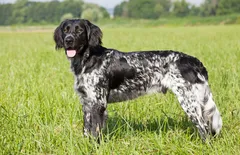
Plott Hound
The Plott is a rugged, relentless hunting dog who is a mellow gentleman at home but fearless, implacable, and bold at work.
Overall Status
| Height | 20 to 25 inches |
| Temperament | Loyal, Alert, Intelligent |
| Weight | 40 to 60 pounds |
| Life Expectancy | 12 to 14 years |
| Coat Color | Black, Black and Tan, Blue, Brown, Red |
| Barking Level | Frequent |
Quick Factors
| Playfulness | |
| Dog Friendly | |
| Exercise Need | |
| Grooming Needs | |
| Strangers Friendly | |
| Family Affectionate |
Daily Care
Grooming Tips
The Plott has a distinctive coat. It’s smooth and fine, but thick enough to protect the dog as he hunts in cold, wet or rough conditions. A few Plotts have a double coat: a short, soft, thick undercoat topped by a longer, smoother, stiffer hairs.Caring for a Plott’s coat is easy. Groom it at least weekly with a rubber curry brush to remove dead hair and distribute skin oils. If your Plott spends a lot of time indoors, you might want to brush him more often to keep dead hair on the brush and off your furniture and clothing. Plotts with a double coat will shed more heavily and need to be brushed two or three times a week.Be aware that scenthounds such as the Plott can have what is often described as a musty odor. Regular baths can help keep the aroma under control, but it’s something you should be prepared to live with.The rest is basic care. Trim the nails as needed, usually every week or two. Keep the hanging ears clean and dry to prevent bacterial or yeast infections. Brush the teeth frequently with a vet-approved pet toothpaste for good overall health and fresh breath.
Exercise Tips
Plotts are tough, relentless athletes requiring lots of exercises and outdoor time. The breed’s standard says: “Noted for stamina, endurance, agility, determination, and aggressiveness when hunting, the powerful, well muscled, yet streamlined Plott combines courage with athletic ability.”Daily vigorous exercise such as long walks or runs or play sessions with his owner will help to keep the Plott mentally and physically healthy. Because the Plott is extremely prey driven, he should always be walked on a leash.
Feeding Tips
All hunting dogs require high-quality food specifically created for their activity levels. Considering the Plott is an avid hunter, he needs specialized food. It is best to feed dry kibble as this can cut down on veterinary bills associated with tooth decay and gum disease.It is essential that the Plott’s meals be separated into two smaller meals as opposed to one large meal. Exercise should be prohibited after meals. This breed is predisposed to gastric torsion, also known as bloat. This life-threatening condition can be prevented with smaller meals and limited exercise after eating.Any diet should be appropriate to the dog’s age (puppy, adult, or senior). Some dogs are prone to gettingoverweight, so watch your dog’s calorie consumption and weight level.Treatscan be an important aid in training, but giving too many can cause obesity. Learn about whichhuman foodsare safe for dogs, and which are not. Check with your vet if you have any concerns about your dog’s weight or diet.Clean, fresh water should be available at all times.
Health Tips
The Plott is an incredibly healthy dog.Gastric torsionis the main issue within the breed that can be devastating. Plotts do tend to experience a high incidence of ear infections. This is due to the warmth inside of the ears because they are dropping. Weekly ear cleaning can help to avoid infections.
Trainability
Because of his keen intelligence and eagerness to please his family, the Plott is a wonderful student. It is important that the owner ensures that the Plott understands his role in the pack as Plotts tend to try to become the dominant one in the pack. This can never be allowed. The dog must be taught his place from an early age. Treats and praise will work better than harsh words and manhandling with this breed.Those who plan to use their Plotts for hunting will be pleasantly surprised. It takes almost no training at all for this breed to hunt. They go on pure instinct and do rather well. Learning the dog’s signals and voice will be better than all the training in the world to the owner.
History
The Plott Hound is the only American hound without British ancestry. In 1750 Jonathan Plott and his brother left Germany bound for America. They took with them five Hanoverian Hounds. Jonathan Plott's brother died during the trip but Jonathan settled in North Carolina. It was there that he raised a family and bred his dogs.A mix ofBloodhoundsand Curs reportedly comprised the original stock. For the next 200 years, the dogs were bred by generations of Plott family members and were referred to as the Plott's hounds. The dogs worked at hunting bear and raccoon in the Appalachian, Blue Ridge and the Great Smoky Mountains of the eastern United States.The Plott family rarely put the dogs on the market so they remained rare outside the southern United States. The dogs were recognized for the first time in 1946 by the United Kennel Club. Plotts are hardy and have superior hunting instincts.They are very effective in the search for coyotes, wolves and wildcats. The breed was carefully developed to be stronger and more persistent. They were able to make good family companions but were seldom kept as such, as most owners acquired the dogs for the hunt. In 2006 the breed was officially recognized by the AKC as the "Plott" and is now shown as a show dog, but there are many who still hunt and breed them as hunting dogs.






